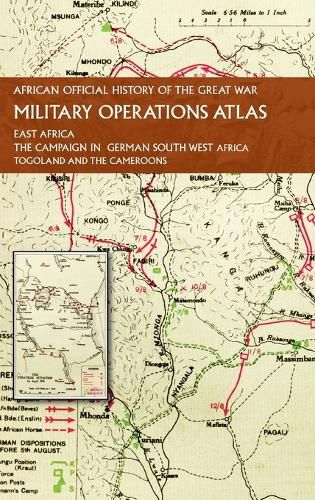Readings Newsletter
Become a Readings Member to make your shopping experience even easier.
Sign in or sign up for free!
You’re not far away from qualifying for FREE standard shipping within Australia
You’ve qualified for FREE standard shipping within Australia
The cart is loading…






This title is printed to order. This book may have been self-published. If so, we cannot guarantee the quality of the content. In the main most books will have gone through the editing process however some may not. We therefore suggest that you be aware of this before ordering this book. If in doubt check either the author or publisher’s details as we are unable to accept any returns unless they are faulty. Please contact us if you have any questions.
EAST AFRICA August 1914--September 1916
THE CAMPAIGN IN GERMAN SOUTH WEST AFRICA 1914-1915
TOGOLAND AND THE CAMEROONS 1914-1916
A full assembly of all the valuable colour and black-and-white maps that were bound into the celebrated African Other Theatre volumes of the Official History of the Great War.
The First World War represented a turning point in African history, not as dramatic as the Second World War, but nevertheless important in many areas. One of its most important legacies was the reordering of the map of Africa roughly as it is today.
Campaigns were fought on African soil which - though they only marginally affected the overall course of the Great War - had significant implications for Africa. More than a million African soldiers were involved in these campaigns or campaigns in Europe. Even more men, as well as women and children, were recruited, often forcibly, as carriers to support armies whose supplies could not be moved by conventional methods such as road, rail or pack animal. Over 150,000 soldiers and carriers lost their lives during the war. Many more were wounded and disabled. By the time the war ended, every country in Africa - with the exception of the small Spanish territories, which remained neutral - had been formally committed to one side or the other. Belgian, British, French, Italian and Portuguese administrations were allied - more or less actively - against German colonies.
$9.00 standard shipping within Australia
FREE standard shipping within Australia for orders over $100.00
Express & International shipping calculated at checkout
This title is printed to order. This book may have been self-published. If so, we cannot guarantee the quality of the content. In the main most books will have gone through the editing process however some may not. We therefore suggest that you be aware of this before ordering this book. If in doubt check either the author or publisher’s details as we are unable to accept any returns unless they are faulty. Please contact us if you have any questions.
EAST AFRICA August 1914--September 1916
THE CAMPAIGN IN GERMAN SOUTH WEST AFRICA 1914-1915
TOGOLAND AND THE CAMEROONS 1914-1916
A full assembly of all the valuable colour and black-and-white maps that were bound into the celebrated African Other Theatre volumes of the Official History of the Great War.
The First World War represented a turning point in African history, not as dramatic as the Second World War, but nevertheless important in many areas. One of its most important legacies was the reordering of the map of Africa roughly as it is today.
Campaigns were fought on African soil which - though they only marginally affected the overall course of the Great War - had significant implications for Africa. More than a million African soldiers were involved in these campaigns or campaigns in Europe. Even more men, as well as women and children, were recruited, often forcibly, as carriers to support armies whose supplies could not be moved by conventional methods such as road, rail or pack animal. Over 150,000 soldiers and carriers lost their lives during the war. Many more were wounded and disabled. By the time the war ended, every country in Africa - with the exception of the small Spanish territories, which remained neutral - had been formally committed to one side or the other. Belgian, British, French, Italian and Portuguese administrations were allied - more or less actively - against German colonies.